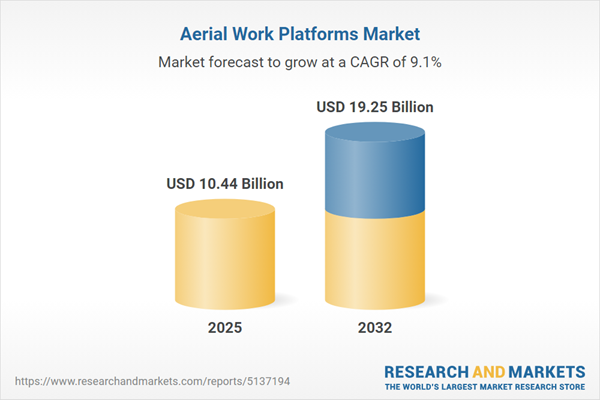Speak directly to the analyst to clarify any post sales queries you may have.
The aerial work platforms market is undergoing rapid transformation, shaped by shifting industry demands, new regulations, and technological progress. Senior decision-makers require clear, actionable analysis to guide investment and strategy in this evolving landscape.
Market Snapshot: Aerial Work Platforms Market Size and Growth
The aerial work platforms market advanced from USD 9.58 billion in 2024 to USD 10.44 billion in 2025 and is forecasted for ongoing growth with a 9.11% CAGR, reaching USD 19.25 billion by 2032. Factors such as mounting demand in construction, industrial, and maintenance applications, along with improvements in electrification and safety features, support this upward trajectory. Investments in infrastructure and adoption of cleaner, greener practices are further propelling market development and reshaping procurement approaches across key sectors.
Scope & Segmentation of the Aerial Work Platforms Market
This aerial work platforms market report provides comprehensive insight and granularity across segments and regions, enabling targeted decision-making and opportunity identification. Covered domains include:
- Platform Type: Includes boom lifts, personnel lifts, scissor lifts, and telehandlers, each serving different usage scenarios from high-reach access to compact indoor maintenance.
- Operation Mode: Covers diesel and electric options, important for deployments ranging from remote industrial worksites to urban construction zones.
- End User: Encompasses construction, industrial, and maintenance applications, highlighting the diversity of operational environments and lifecycle needs.
- Height Range: Breaks down solutions for projects up to 20 meters, between 21 and 40 meters, and exceeding 40 meters, addressing a wide range of structural requirements.
- Payload Capacity: Spans up to 250 kilograms, 251 to 450 kilograms, and above 450 kilograms, enabling precise alignment with project needs and safety standards.
- Distribution Channel: Accounts for aftermarket, direct sales, and rental models, which reflect shifting preferences towards flexibility and cost efficiency.
- Regional Analysis: Includes North America, Latin America, Europe, Middle East, Africa, and Asia-Pacific, illustrating global demand drivers, local compliance regimes, and supply chain variations.
- Key Companies Profiled: Features Terex Corporation, Haulotte Group S.A., Linamar Corporation, Xuzhou Construction Machinery Group Co., Ltd., Jiangsu Sinoboom International Machinery Co., Ltd., Dingli Machinery Co., Ltd., Manitou BF S.A., Niftylift Limited, MEC Aerial Work Platforms, LLC, and Palfinger AG.
Key Takeaways for Senior Decision-Makers
- Telematics and IoT-based monitoring technologies are driving operational efficiencies, enabling predictive maintenance and enhancing worker safety across diverse settings.
- Electrification and hybridization of equipment are gaining momentum, particularly in densely populated and tightly regulated areas focused on sustainability and low emissions.
- Collaborations among OEMs, rental companies, and technology providers are fueling product and service innovation, allowing tailored solutions to meet enterprise needs.
- Regional variations in infrastructure spending and urbanization are leading to differentiated purchasing patterns and supporting the adoption of local assembly strategies.
- Rental and aftermarket channels are critical for capturing long-term value, as businesses prioritize operational flexibility, streamlined costs, and adaptable financing choices.
- Manufacturers are emphasizing local production and agile sourcing tactics to reduce risk and adapt to regulatory and tariff changes affecting supply chains.
Tariff Impact on the Aerial Work Platforms Market
New United States tariffs on essential components such as steel structures and electronic controls, effective from 2025, are compelling original equipment manufacturers to reassess sourcing strategies and supplier agreements. This shift is anticipated to impact production costs, affecting price structures in maintenance and industrial segments. Rental operators may modify their offerings to offset volatility, while manufacturers increasingly consider nearshoring to maintain stable operations and safeguard profitability.
Methodology & Data Sources
This report’s findings are based on a blend of primary and secondary research methods, including interviews with OEM executives, rental firms, and end users. Additional information was drawn from industry groups, regulatory documentation, company records, and international trade data. Triangulation techniques and expert reviews ensured objectivity and data integrity.
Why This Report Matters
- Enables organizations to keep pace with evolving trends, regulatory influences, and technological innovations shaping access equipment markets.
- Equips supply chain and product leaders with the intelligence needed for resiliency planning, partnership development, and resource optimization across targeted geographies.
- Supports budgetary planning and risk assessment by anticipating shifts in regional demand and pricing dynamics within the current regulatory context.
Conclusion
This analysis provides senior decision-makers with actionable insights for capitalizing on new opportunities and mitigating emerging risks in the aerial work platforms market. Navigate future industry changes with informed confidence.
Additional Product Information:
- Purchase of this report includes 1 year online access with quarterly updates.
- This report can be updated on request. Please contact our Customer Experience team using the Ask a Question widget on our website.
Table of Contents
3. Executive Summary
4. Market Overview
7. Cumulative Impact of Artificial Intelligence 2025
List of Figures
Samples

LOADING...
Companies Mentioned
The key companies profiled in this Aerial Work Platforms market report include:- Terex Corporation
- Haulotte Group S.A.
- Linamar Corporation
- Xuzhou Construction Machinery Group Co., Ltd.
- Jiangsu Sinoboom International Machinery Co., Ltd.
- Dingli Machinery Co., Ltd.
- Manitou BF S.A.
- Niftylift Limited
- MEC Aerial Work Platforms, LLC
- Palfinger AG
Table Information
| Report Attribute | Details |
|---|---|
| No. of Pages | 194 |
| Published | October 2025 |
| Forecast Period | 2025 - 2032 |
| Estimated Market Value ( USD | $ 10.44 Billion |
| Forecasted Market Value ( USD | $ 19.25 Billion |
| Compound Annual Growth Rate | 9.1% |
| Regions Covered | Global |
| No. of Companies Mentioned | 11 |









